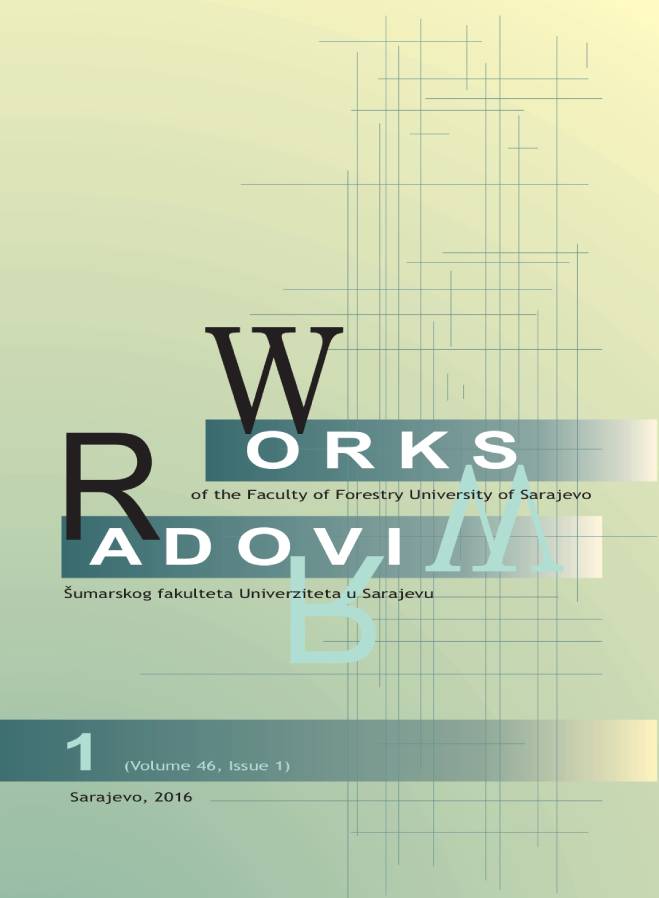Geostatistička tehnika procjene drvnih zaliha u šumskim sastojinama male površine na bazi inventurnih, okolišnih i spektralnih podataka Landsat 8
DOI:
https://doi.org/10.54652/rsf.2016.v46.i1.75Ključne riječi:
growing stock, geographically weighted regression, forest inventory, environmental data, Landsat 8Sažetak
UDK: 630*52:311
U okviru regularnih periodičnih inventura državnih šuma prikuplja se veliki broj podataka i informacija koje omogućavaju detaljniji uvid u strukturne i proizvodne karakteristike šuma. Kada su u pitanju privatni šumski posjedi kod kojih dominiraju male površine šume, inventure su manje intenzivne uz veći utrošak vremena prelaza od posjeda do posjeda s obzirom da su šumoposjedi locirani većinom raspršeno na brdskim, padinskim ili u ravničarskim predjelima.
U ovom radu su analizirane dvije regresione tehnike procjene krupne drvne mase po ha sa ciljem da se utvrdi mogu li regresijske procjene zasnovane na uzorku regularne inventure šuma biti dovoljno precizne za procjenu drvne zalihe u sastojinama manjih površina lociranim na rubnim područjima velikih kompleksa državnih šuma. Primjenjene su višestruka linearna regresija po metodu najmanjih kvadarata (OLS) i geografski ponderisana regresija (GWR) koja uvažava lokacijski varijabilitet procjenjivane varijable. Kao prediktori su analizirani okolišni (nadmorska visina, nagib, ekspozicija, pozicijska lokacija) i radiometrijski transformisani spektralni podaci Landsat 8 satelitskog snimka.
Regresionim analizama su određeni OLS i GWR regresioni modeli i ustanovljeno da GWR modeli bolje objašnjavaju varijabilitet krupne drvne mase. Za osam rubnih sastojina površine manje od 10 ha procjenjene su veličine krupne drvne mase i ustanovljeno da nema statistički značajnih razlika između prosječnih veličina određenih terenskim uzorkom za dominirajuće vrste ili grupe (četinari, lišćari, total) stabala. Ustanovljeno je da GWR procjene bolje prate raspodjelu krupne drvne mase iz terenskog uzorka nego OLS procjene. Zapaženo je da u nekim slučajevima OLS procjene daju manje razlike u odnosu na terenske prosjeke odabranih sastojina nego GWR što se može tumačiti odsustvom lokacijskog uticaja (homogene stanišne i sastojinske prilike).
Dobijeni rezultati ukazuju na potencijal regresionih tehnika u procjeni drvne produkcije u malim prostornim jedinicama pri čemu se GWR može označiti kao tehnika sa boljim performansama. Dalje mogućnosti geografski ponderisane regresije, zasnovane na korištenju terenskih, okolišnih i spektralnih podataka, kao i drugih geostatističkih analiza treba provjeriti u našim specifičnim prirodnim i uređajnim okolnostima u narednim istraživanjima.
Downloads
References
AKHAVAN, R., KIA-DALIRI, H., ETEMAD, V. (2015): Geostatistically estimation and mapping of forest stock in a natural unmanaged forest in the Caspian region of Iran. Caspian Journal of Environmental Sciences. Vol. 13, No. 3, pp 61- 76.
BARHOSA, M.J., MELENDEZ – PASTOR, I., NAVARRO – PEDREÑO, J. AND BITENCOURT, D.M. (2013): Remotely sensed biomass over steep slopes: An evaluation among successional stands of the Atlantic Forest, Brazil. ISPRS Journal of Photogrammetry and Remote Sensing, Vol. 88, pp. 91 – 100.
BENÍTEZ, F. L., ANDERSON, L. O. AND FORMAGGIO A. R. (2016): Evaluation of geostatistical techniques to estimate the spatial distribution of aboveground biomass in the Amazon rainforest using high-resolution remote sensing data. Acta Amazonica. Vol. 46(2) 2016: 151- 160.
CHARLTON, M., FOTHERINGHAND, S. AND BRUNSDON C. (2006): Geographically weighted regression. Esrc National Centre For Research Methods. Ncrm Methods Review Papers Ncrm/006.
CHEN, G., ZHAO, K., MCDERMID J. G. AND HAY J. G. (2012): The influence of sampling density on geographically weighted regression: a case study using forest canopy height and optical data. International Journal of Remote Sensing, Vol. 33, No. 9, pp. 2909 – 2924.
GÜNLÜ, A., ERCANLI, I., BAŞKENT, E. Z. AND ÇAKIR, G. (2014): Estimating aboveground biomass using Landsat TM imagery : A case study of Anatolian Crimean pine forests in Turkey. Annals of forest research, Vol. 57(2), pp. 289 – 298.
MATTIOLI, W., QUATRINI, V., DI PAOLO, S., DI SANTO, D., GIULIORELLI, D., ANGELINI, A., PARTOGHESI L. AND CORONA P. (2012): Experimenting the design – based k-NN approach for mapping and estimation under forest management planning. iForest – Biogeosciences and Forestry, Vol. 5, pp. 26 – 30.
MCROBERTS, E. R., COHEN, B.W., NAESSETE, E., STEHMAN, S. AND TOMPPO, E. (2010): Using remotely sensed data to construct and asses forest attribute maps and related spatial products. Scandinavian Journal of Forest Research, Vol. 25(4), pp. 340 – 367.
MENG, Q. (2014): Regression Kriging versus Geographically Weighted Regression for Spatial Interpolation. International Journal of Advanced Remote Sensing and GIS, Vol. 3(1), pp. 606 – 615.
MONTGOMERY, D.C.; PECK, E.A.; VINING, G.G. (2001): Introduction To Linear Regression Analysis. 3rd ed. John Wiley & Sons, Inc, New York, 672p.
NAKAYA, T. (2014): GWR4 User Manual: Windows Application for Geographically Weighted Regression Modelling. GWR4 Development Team.
OSMANOVIĆ, M., LOJO, A., BALIĆ, B., ČABARAVDIĆ, A., HAJEK, F. (2016): Object based classification using spectral and inventory data in native, mixed beech, fir and spruce forests on Igman mountain. Abstract book. Adavancing horizons for land cover services entering the big data era. May, 6-7, 2016. Prague, Czech Republic.
PROPASTIN, P. (2012): Modifying geographically weighted regression for estimating aboveground biomass in tropical rainforests by multispectral remote sensing data. International Journal of Applied Earth Observation and Geoinformation, Vol. 18, pp. 82 – 90.
PROPASTIN, P., KAPPAS, M. AND ERASMI, S. (2008): Application of Geographically Weighted Regression to Investigate the Impact of Scale on Prediction Uncertainty by Modelling Relationship between Vegetation and Climate. International Journal of Spatial Data Infrastractures Research, Vol. 3, pp. 73 – 94.
SHRIESTA, P. M. (2006). Comparison of Ordinary Least Square Regression, Spatial Autoregression, and Geographically Weighted Regression for Modeling Forest Structural Attributes Using a Geographical Information System (GIS)/Remote Sensing (RS) Approach. Master thesis. Department of Geography Calgary, Alberta. University of Calgary.
TIRYANA, T., TATSUHARA, S., AND SHIRAISHI, N. (2010): Modeling Spatial Variation in Stand Volume of Acacia mangium Plantations Using Geographically Weighted Regression. FORMATH, Vol. 9, pp. 103 – 122.
VAN DER LAAN, C., VERWEIJ A. P., QUIÑONES J. M. AND PC FAAIJ, A. (2014): Analysis of biophysical and anthropogenic variables and their relation to the regional spatial variation of aboveground biomass illustrated for North and East Kalimantan, Borneo. Cabon Balance and Management, Vol. 9.
ZHANG, L., MA, Z. AND GUO L. (2008): Spatially assessing model errors of four regression techniques for three types of forest stands. Forestry 81 (2), pp. 209 – 225.























